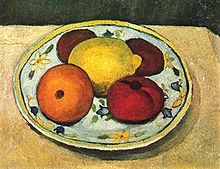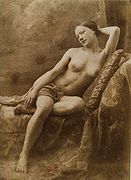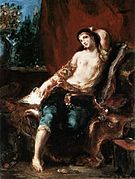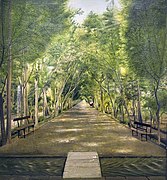Image viewing
Among image viewing or image analysis is defined as a systematic study in which the examined object, the image or the image content, by the visual perception and cognitive processes is decomposed into an act of analysis into its component parts (elements), and then in the Result to be recorded on the basis of specified criteria. In the broadest sense, the process can also be described as image interpretation. In the visual arts , the viewer assumes the position that a viewer or listener has for the performing arts or literature ( recipient ).
The perception is conceptually than the purely subjective result of the visual perception process ( percept ) and its underlying neurophysiological processes (d. E. Visual sensory perception) to distinguish it from the reception.
From the perspective of communication theory , the recipient is the recipient (e.g. viewer, reader, listener, viewer, visitor, user, newsletter subscriber, audience ) of a message in a media communication process that can be described with the help of various communication models. The recipient is the person who wants to get information and / or should be informed. He already plays an active role because he is "ready to receive". The sender (e.g. painter, draftsman, speaker, author) is referred to as the communicator in this process . The interaction between sender and receiver is called feed back . The exchange of information, in this case visual communication, is achieved through the use of visible signs . In the visual arts, signs are traditionally linked to the corresponding media such as painting, photography, film, architecture, etc. ( iconography , mediology ).
The reception aesthetics asks about the mental and emotional perception of artistic works and to what extent it is already created in the object or only in the process of reception is produced.
The psychology of perception (about figure-ground , visual illusion , monocular space perception ) with its concepts and findings may be important for understanding the image viewing.
Structure of the image description
The image description in writing is divided into introduction , body and conclusion. The analysis begins purely descriptively : the visible elements are described objectively. The established analysis methods for describing images (e.g. semiotic , inconographic-iconological , reception-aesthetic ) are often structured in a similar way: after a description that is as objective as possible an interpretation follows .
method
In a first step of the image analysis it is necessary to look at the image or the image content extensively and intensively or to allow it to work on you. In a second step, you can make notes, for example which facts emerged when looking at them and which aspects stood out. It should be noted, however, that the more inconspicuous incidents are also noted or documented. The third step summarizes the general information about the artist, the time of creation, etc. about the work ( introduction ). In a fourth step, the facts to be collected about the image, such as colors and materials and content, must be sorted ( syntactic level of image analysis ). For technical reasons, the collected abnormalities should be entered in an overview. This can also be subdivided in a table to enable easier access.
introduction
To take stock of the situation, the following must be written down, information on the subject , for example a still life , a flower still life, a landscape , a model . Furthermore, important information about the picture itself and its creator should not be missing in an introduction, i.e. name of the artist, title of the picture, time and place of creation, size or information on format, type (e.g. drawing , etching , painting , photography ).
Francisco de Goya : Por liberal ,
1814–1820,
( brush drawing , ink with sepia )Eugène Durieu : Photograph of a seated female nude.
Design template for the painting Odalisque by Eugène DelacroixEugène Delacroix : Odalisque
(painting, oil on wood)
The next step is a description of the subject of the work, so what does the work mainly depict? Linked to this is, from the position of the viewer, a description of the objective and formal structure of the respective image or image content. This should be done in an orderly and image-immanent sequence, for example in the sequence from the image foreground to the background or, starting from the central image objects, up and down or left to right. For the verbalization of the image structure, the subdivision of the image into one:
- foreground
- Middle ground
- background
become important.
Bulk
The individual picture elements of the figure are related to each other in the main part. Here, a syntactic (what, how, how was combined on the picture surface or signs and their formal relationship to other signs) can be distinguished from a semantic (what one sees and how one interprets what is seen or the meaning of the signs in terms of content) level of image analysis .
Syntactic level of image analysis
There are different approaches here. Either you first describe the essentials and then go into the details or you start with the details and work your way towards the more essential. The goal in all of these approaches, however, remains to find and verbalize the structure inherent in the work of art. This makes the contexts of meaning and relationships transparent and contexts of meaning comprehensible. It is important that you state exactly where the corresponding “syntagm” is located in the picture. Syntactics or the structured description of the image are made using the following points:
-
Arrangement of the picture area:
- Are there axes, lines, curves, partial areas that structure the picture surface?
- Are there outlines with which the people and objects shown are drawn? The outlines delimit the object from its surroundings (colored area).
- Are there axes, lines, curves, partial areas that structure the picture surface?

Watercolor with outlines accompanying the objects.
- What are the effects of this arrangement of the picture surface? Symmetry, calm, tidiness, firmness, balance, immobility or static, movement, dispersion, compression, restlessness, tension, drama.
-
Arrangement of the picture space:
- Which light sources (natural sun, moon or artificial torchlight, lamps, candles) can be seen or are there? Light and shadow effects (plasticity) or which picture elements are placed in the light or shadow ?;

Natural light with a shadow effect.
- Spatiality as a visual simulation of space in a two-dimensional image: perspective , what perspective there is, a vanishing point can be identified. What kind of spatial representation is created by the creator; there are overlaps in the visual simulation of the room, how are placed here by size contrasts;
- Viewing perspectives
Pietro Perugino : Frescoes in the Sistine Chapel .
Scene: Christ gives the keys to Peter.
Central perspective with a vanishing point.Henricus Hondius : drawing with two vanishing points.
Kamal-ol-whey : Doshan tap .
Central perspective with a vanishing point .
One area of space lies parallel to the image plane, this is depicted parallel to the image, the other is orthogonal to it - its areas of space are aligned in one pointJohann Erdmann Hummel .
Frontal perspective of a roomRepresentation from the Manessian song manuscript (14th century): The nobles are represented much larger than the musicians. Meaning perspective.
- Are there other representational means to simulate a spatial depth effect?
- Differences in height of objects; it is an old and simple means of representing space. Objects that are arranged in the image below are in the front, those that are further up are in the back.
- Covering of objects; Objects with partially covered shapes appear to be further away or deeper in the room than uncovered ones.
- Graduation of objects; an overlap of image objects in a certain direction of the image space with systematic distances is presented.
- Differences in size of objects; If image objects, which are the same size in reality, are displayed in different sizes on the image plane, artificial size difference, the smaller objects appear to be further away than the larger ones. A reverse process is the reduction of the picture elements from bottom to top on the picture plane instead of a depth of space.
- Are there other representational means to simulate a spatial depth effect?
-
Arrangement of the picture objects:
-
Motif , what was shown;
- Description of people, objects; based on their gender , appearance, age , stature , posture, facial expressions , gestures , clothing , function, etc.
- Description of the location of the action, the nature of the landscape, what architecture; which accesses and ways through the picture are presented.
- Description of the era as far as possible.
- Eye guidance ( eye movement registration );
- Although the (possible) movements are “frozen” in a picture, the eyes wander “around in it” according to a certain movement pattern, so-called main lines of the picture can guide the movement patterns: One can determine four line orientations: ascending, descending, horizontal and vertical.
-
Action , scene of a picture shows itself to be “frozen”, so to speak. A before and after can be derived, speculated or reconstructed from the plot or scene.
- “Elliptical analysis” how does the action, scene of an image change through the successive omission of individual image elements?
- So what happened in time, a goal can be presumed; what preceded, what follows, who relates to whom, who does what?
- Composition , general design elements , triangular composition, then the composition of formal elements , then the use of the golden ratio , movement lines;
-
Motif , what was shown;

- Proportionality of the individual objects and people, what is their relationship to one another and to the environment, to the whole, to the viewer;
- Are there predominant forms in the picture? Form language, such as surface, basic geometric shapes, line, structure, contour;
-
Arrangement of colors:
- Basic elements ; which color was used and how, with what intensity was the color applied, how is the color tone and rhythm designed, overall coloring , color focus;
- Contrasts , color relationships, color perspective ( color theory );
-
Arrangement of materials:
- Materials, effect of the painting or drawing material ;
- Materiality of the pictorial medium ( charcoal , oil paint , acrylic paint , red chalk , tempera , etc.);
- Materiality of the image carrier ( canvas , cardboard , paper , glass , etc.);
- Painting technique , linework , brush marks , sfumato , painting knife .
Strong color contrasts in a photograph .
Francisco de Goya : Self-Portrait .
Example of a light-dark contrast .Michelangelo Merisi da Caravaggio : The incredulous Thomas .
Example of a light and shadow effect.Leonardo di ser Piero da Vinci : The Last Supper .
Example of a picture arrangement in the golden ratio .
Colourfulness
- Which color tone or shades were chosen? How do the shows brightness or color intensity .
- Can you see contrasts in the picture? Color contrasts ( light-dark , cold-warm , complementary , quantity , simultaneous , quality , successive contrast );
- Application of paint ( pasty , opaque , watercolor, flat, directional);
- Which color spectrum is predominantly used? If a color spectrum is preferred, blue tones, red tones, green tones.
- Relationship of the applied color to the object:
- Local color , color corresponds to the "natural color";
- Appearance color, color as "painting of light" ( impressionism );
- Color modulation ;
- Color of expression Color is used independently of the object and serves to enhance the expression of the image.
Spatiality
The creator must subdivide the pictorial space available to him according to his compositional considerations in order to allow his visual simulation of space in a two-dimensional representation through the spatial references (foreground, middle ground, background) and the decisions about the means of body and space representations on the To give expression to the picture.
Ultimately, the representation of the body and space on the image surface (by means of the image means and carriers) could in principle be covered mathematically precisely by the representing geometry , it is a sub-area of the geometry . After all, it is the geometrical-constructive process that deals with the projections of three-dimensional objects onto a two-dimensional display plane. In the fine arts, the concept of different types of perspective representations is used to summarize the possibilities of depicting three-dimensional objects on a two-dimensional surface in such a way that a spatial impression is created.
- How is the existing image space divided, how is it used by the artist?
- Is the space presented naturalistic or twisted, distorted or disharmonious?
End of the picture description
In the summary of what has been described, the pragmatic description of the picture is used as an additional aspect: What is the temptation of what is shown in the picture?
See also
literature
- Régis Debray : Beyond the Pictures. A history of image viewing in the West. Rodenbach 1999 (or 2nd edition 2007, Avinus Verlag), original title Vie et mort de l'image. Une histoire du regard en Occident , published in 1992 in Paris by Gallimard.
- Werner Faulstich (ed.): Image analysis: paintings, photos, advertising images. Scientists-Verlag, Bardowick 2010, ISBN 978-3-89153-035-1 . (opus.uni-lueneburg.de)
- Gotthard Jedlicka : sight and experience. Viewing images. Suhrkamp (Library Suhrkamp 29), Frankfurt am Main 1955
- Konrad Lischka: Iconography and Iconology as Methods of Image Analysis in Communication Studies. Grin Verlag, Munich / Ravensburg 2013, ISBN 978-3-640-32680-8 .
- Michael R. Müller, Jürgen Raab, Hans-Georg Soeffner (eds.): Limits of image interpretation (knowledge, communication and society). Springer, Berlin / Heidelberg / New York 2014, ISBN 978-3-658-03996-7 .
- Johannes Steinmüller: Image analysis: From image processing to spatial interpretation of images. Springer, Berlin / Heidelberg 2008, ISBN 978-3-540-79742-5 .
- R. Suckale, M. Wundram, IF Walther: Painting of the world. An art history in 900 image analyzes. Volume I: From Gothic to Classicism. Cologne 1995
- Theodor Volbehr : viewing the picture. An introduction to all levels of school teaching. 1922
Web links
- Image analysis. Kunstunterricht.ch - teaching aids for Swiss art lessons / artistic design. Ed .: Thomas Schatz. kunstunterricht.ch
- Specialized vocabulary and aids for image analysis. Abiturwissen Kunst, Stark Verlag 2012, pp. 1–4 kunstimunterricht.de
Individual evidence
- ↑ Recipient from Latin recipere 'to take in, to receive'
- ↑ Barbara Pfeuffer: Abitur knowledge - art analysis and interpretation: analysis and interpretation - advanced course. Stark Verlag, Freising 2011, ISBN 978-3-89449-207-6 , p. 129 f.
- ↑ image analysis, artwebs.de artwebs.de
- ↑ More precisely, the "eye-tracking" recordings mainly reveal the following eye movements; consisting of fixations (points that you look at closely), saccades (rapid eye movements) and regressions of existing eye movements of a person.

















